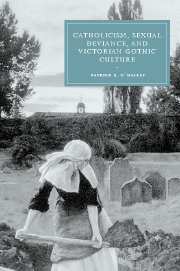Book contents
- Frontmatter
- Contents
- List of illustrations
- Acknowledgments
- Introduction: skeletons in the cloister
- 1 Goths and Romans: the literature of Gothic from Radcliffe to Ruskin
- 2 “The Church's closet”: Victorian Catholicism and the crisis of interpretation
- 3 Domestic Gothic: unveiling Lady Audley's Secret
- 4 The blood of the saints: vampirism from Polidori to Stoker
- 5 “Monstrous and terrible delight”: the aesthetic Gothic of Pater and Wilde
- 6 Conclusions: Oxford's ghosts and the end of the Gothic
- Notes
- Works cited
- Index
- CAMBRIDGE STUDIES IN NINETEENTH-CENTURY LITERATURE AND CULTURE
2 - “The Church's closet”: Victorian Catholicism and the crisis of interpretation
Published online by Cambridge University Press: 06 July 2010
- Frontmatter
- Contents
- List of illustrations
- Acknowledgments
- Introduction: skeletons in the cloister
- 1 Goths and Romans: the literature of Gothic from Radcliffe to Ruskin
- 2 “The Church's closet”: Victorian Catholicism and the crisis of interpretation
- 3 Domestic Gothic: unveiling Lady Audley's Secret
- 4 The blood of the saints: vampirism from Polidori to Stoker
- 5 “Monstrous and terrible delight”: the aesthetic Gothic of Pater and Wilde
- 6 Conclusions: Oxford's ghosts and the end of the Gothic
- Notes
- Works cited
- Index
- CAMBRIDGE STUDIES IN NINETEENTH-CENTURY LITERATURE AND CULTURE
Summary
The Priests use the Confessional to obtain the secrets of the individual, the household, or the State. They use it to corrupt, pervert, and enslave their victims – to satiate their own lust, avarice, ambition, and malice. It is “the Church's” closet for pry, intrigue, and “ambiguous familiarity.”
The Oxford and Roman Railway (1871)As my preceding chapter has argued, the novels of Ann Radcliffe, Matthew Lewis, and (to some extent) Charles Maturin displaced the sexual and religious transgressions represented by the Gothic onto the Catholic Continent; it is precisely the absurdity of the idea of those transgressions appearing in the Midlands of England that Jane Austen's Henry Tilney mocks. The religious controversialists of the mid-nineteenth century, however, brought that Gothic rhetoric firmly into England. Freeing the Gothic from its coffin of dead generic tropes, they breathed new life into the ideological structures of Gothic discourse, making that discourse a staple of historical as well as fictional cultural production. On the one hand, this represents a certain kind of evangelical hysteria, an increasingly desperate warning that Catholics in England are aiming for a radical new imposition of the medieval perversions of the Inquisition and the Papal courts. On the other hand, it is precisely through this sort of attack that anti-Catholic evangelicals themselves ironically provide the discourse necessary for imagining and theorizing what the presence of Catholics (Roman or ritualist) – and, for that matter, persons of nonnormative sexualities – might mean for England.
- Type
- Chapter
- Information
- Catholicism, Sexual Deviance, and Victorian Gothic Culture , pp. 72 - 102Publisher: Cambridge University PressPrint publication year: 2006



